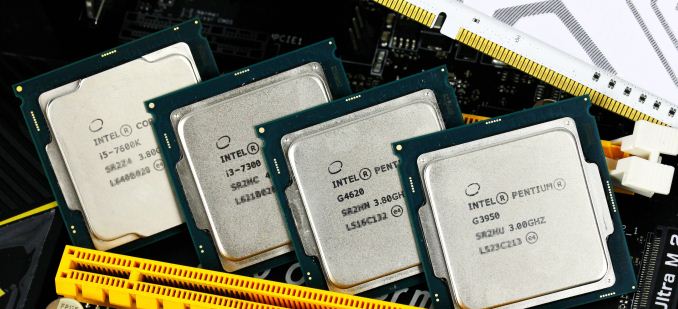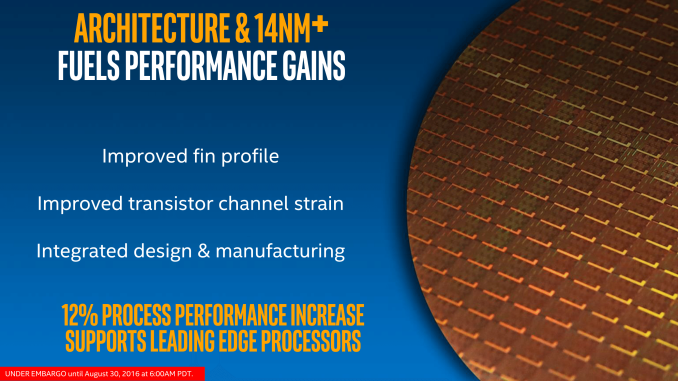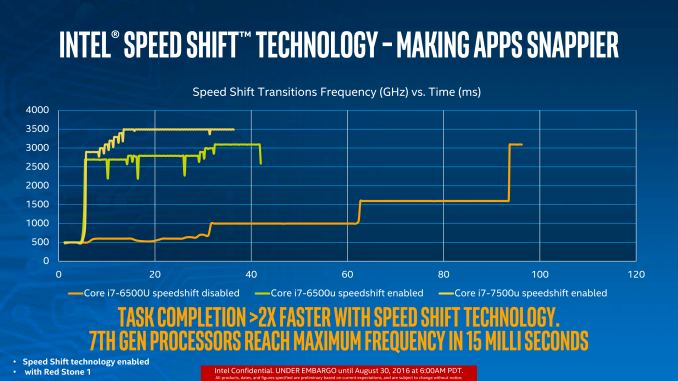Desktop Kaby Lake-S i7/i5 Lineup and 200-Series Chipsets Leaked
by Ian Cutress & Anton Shilov on October 31, 2016 10:00 AM EST- Posted in
- CPUs
- Intel
- 14nm
- Kaby Lake
- 200-series

Intel has already started to sell low-power dual-core Core i5/i7 Kaby Lake microprocessors for notebooks, but desktop parts with four cores and high frequencies are due in early 2017, as Intel announced back at IDF and the Kaby Lake-Y/U launch. In advance of the desktop launch, as is typical with how CPUs are launched, Intel has to send out qualification and near-retail samples to partners for pre-testing of release systems. Typically this is kept under wraps, without official public announcements (it's up to you how many of the leaks you want to believe), but late last week Intel sent out a 'Product Change Notification' through its online/public channels, with details about a good portion (no way to tell if it is all the SKUs) of Intel's Core i7 and Core i5-7000 series parts.
Within the PCN, Intel notified its customers about an additional assembly/packaging site for its desktop Kaby Lake-S chips in Vietnam and therefore had to disclose model numbers of the CPUs as well as some of the specifications. In addition, in a separate PCN detailing package adjustments for how chipset ICs are shipped, it would seem that Intel has also mentioned names of its upcoming 200-series chipsets.
According to Intel’s document for partners, the company intends to release at least 11 quad-core processors for desktops based on the Kaby Lake microarchitecture in Q1. What is noteworthy is that the company wants its customers to get ready to receive the first shipments of the KBL-S chips assembled in Vietnam starting from November 4, 2016, this week (which means that the final specs of the new processors have been set and will only be changed in extreme circumstances). The initial KBL-S lineup would seem to include three Core i7 SKUs, seven Core i5 CPUs as well as one Xeon E3 v6 product. (The fact that a Xeon v6 is included in this is interesting, given that Intel removed standard chipset support for Xeon E3 CPUs with Skylake and v5, meaning that both consumer and enterprise platforms are due to land in January.)
All the Kaby Lake-S processors will use the B0 stepping of the core, and will have 100-300 MHz higher base frequency compared to their Skylake-S counterparts. The PCN does not explicitly state the TDP, however we do not expect much to change given the slightly improved 14+ nm technology and the increased frequencies (same thing applies to cache size, which has been consistent for several generations). We have already observed that mobile Kaby Lake CPUs have higher clock rates compared to their predecessors due to enhancements of Intel’s 14+ nm process technology, and we see that their desktop brethren also have improvements on this front. We do not have the final Turbo frequencies at hand, but we expect them to be considerably higher than the base clock rates.
| Basic Specifications of Quad-Core Intel Core i5/i5 and Xeon E3 | |||||||||
| Kaby Lake-S | Skylake-S | ||||||||
| Model | Cores /Threads |
Freq. (Base) |
TDP | Product Code |
S-Spec | Model | Freq. (Base) |
||
| i7-7700K | 4/8 | 4.2 GHz | 95W | CM8067702868535 | SR33A | i7-6700K | 4.0GHz | ||
| i7-7700 | 3.6 GHz | 65W | CM8067702868314 | SR338 | i7-6700 | 3.4GHz | |||
| i7-7700T | 2.9 GHz | 35W | CM8067702868416 | SR339 | i7-6700T | 2.8GHz | |||
| i5-7600K | 4/4 | 3.8 GHz | 95W | CM8067702868219 | SR32V | i5-6600K | 3.5GHz | ||
| i5-7600 | 3.5 GHz | 65W | CM8067702868011 | SR334 | i5-6600 | 3.3GHz | |||
| i5-7600T | 2.8 GHz | 35W | CM8067702868117 | SR336 | i5-6600T | 2.7GHz | |||
| i5-7500 | 3.4 GHz | 65W | CM8067702868012 | SR335 | i5-6500 | 3.2GHz | |||
| i5-7500T | 2.7 GHz | 35W | CM8067702868115 | SR337 | i5-6500T | 2.5GHz | |||
| i5-7400 | 3.0 GHz | 65W | CM8067702867050 | SR32W | i5-6400 | 2.7GHz | |||
| i5-7400T | 2.4 GHz | 35W | CM8067702867915 | SR332 | i5-6400T | 2.2GHz | |||
| E3-1205v6 | ?/? | 3.0 GHz | ? | CM8067702871025 | SR32D | - | - | ||
| Additional Info from Other Sources | |||||||||
| i3-7300* | 2/4 | 4.0 GHz | 65W | ? | SR2MC | i3-6300 | 3.8 GHz | ||
| Pentium G4620* | 2/2 | 3.8 GHz | 51W | ? | SR2HN | Pentium G4520 | 3.6 GHz | ||
| Pentium G3950* | 2/2 | 3.0 GHz | 51W | ? | SR2MU | Pentium G3920 | 2.9 GHz | ||
*CPU details taken from this piece at PCOnline
Aside from the 14+ process offering higher frequencies, the base microarchitecture of Kaby Lake-S, as explained at the release of Kaby Lake-Y/U in September, is essentially the same as Skylake. However, on top of increasing the frequencies, Intel is also adding in Speed Shift v2 which allows for much quicker adjustments in CPU frequency over Skylake (down to 10ms rather than 30ms).
It remains to be seen is whether the new 14+ process technology will also enable considerably higher overclocking potential compared to existing CPUs. If it does, then the new chips have a chance to become rather popular among enthusiasts, potentially toppling the i7-2600K as a long term favorite.
It might be noted is that Intel’s Kaby Lake-S will have to compete not only against their predecessors, but also against AMD’s Zen products due in Q1. That being said, some would argue that given AMD's recent presentation of certain benchmark metrics, Zen is geared more towards the high-end desktop crowd. Nevertheless, it looks like early 2017 is going to be an interesting time for microprocessors.
200-Series Chipsets
In addition to model numbers of its Kaby Lake CPUs, Intel also revealed the names of its 200-series chipsets in another document it sent to partners. As expected, the lineup will include the Z270 PCH for enthusiast-class PCs with overclocking capabilities; Q270, H270 and H250 for mainstream systems and B250 for office/business computers.
| Intel 200-Series Chipsets | ||||||
| Name | Socket | Stepping | Product Code | S-Spec | ||
| Intel H270 | LGA1151 | A0 | GL82H270 | SR2WA | ||
| Intel Z270 | GL82Z270 | SR2WB | ||||
| Intel B250 | GL82B250 | SR2WC | ||||
| Intel Q250 | GL82Q250 | SR2WD | ||||
| Intel Q270 | GL82Q270 | SR2WE | ||||
| Intel C422 | LGA1151? | A0 | GL82C422 | SR2WG | ||
| Intel X299 | ?!? | A0 | GL82X299 | SR2Z2 | ||
Also in the list of chipsets were a couple of unknowns as well.
Listed in the PCN is C422, which because it has a 'C' in the name means that this is typically geared towards workstations and Xeon platforms. This may be in line with the E3-1205 v6 CPU SKU as seen in the processor list.
Also is X299, which really throws up a few question marks. The X-series chipsets are typically for Intel's High-End Desktop Platform (HEDT), and we've had X58, X79 and X99 in the last decade, from Nehalem up to Broadwell-E which was released back in May. This means either one of two things - either Intel is bringing the X nomenclature to Kaby Lake, the mainstream platform, or this is the next chipset for HEDT and the future Skylake-E series of processors. The first option in making X299 a Kaby Lake-related platform seems a little odd. However the second one, with Skylake-E, makes sense. After X99, the X119 name doesn't have the same marketability (if Intel was to keep parity with number jumps), but by pushing Skylake-E onto the 200-series naming as X299, it moves both mainstream and HEDT chipset naming strategies onto the same track. Note that we don't have a time-frame for Skylake-E as of yet.
Intel’s motherboard customers, given the Q1 launch, must be ready to receive the 200-series PCH ICs on new reels. According to the PCN, these will come with additional protections bands starting from December 2, 2016. Intel may or may not announce the whole 200-series (not X) lineup at CES, given this late in the day adjustment to core components for the motherboards.
As for improvements of the Intel 200-series chipsets, we are still waiting on official confirmation as to exactly what to expect. Various unconfirmed leaks have indicated additional PCIe 3.0 chipset lanes, some new platform features and support for Intel’s Optane SSDs, however we will be here for the official launch when the time comes. It might be worth noting that almost all the motherboard manufacturers have now formally announced new 100-series BIOS support for Kaby Lake CPUs, meaning not all enthusiasts will have to get new motherboards.


















72 Comments
View All Comments
Lolimaster - Monday, October 31, 2016 - link
12% performance increas is just from the increased clocks, this things don't even deserve news.ikjadoon - Monday, October 31, 2016 - link
I wonder if this is even good for overclockers. We would presume, on a "better" process, they got higher MHz at lower voltages (to stay within that 95W TDP envelope).But...honestly.....the i5-6600K (rated at 91W) maxes out around 70W. Technically, Intel may have just pre-overclocked Skylake a smidgen.
If true, they'll run hotter than Skylake...because they just raised the voltage a smidgen, too.
Well, this is a win for non-overclockers, though. Intel finally gives them that 'free performance that overclockers enjoy.
saratoga4 - Monday, October 31, 2016 - link
>Technically, Intel may have just pre-overclocked Skylake a smidgen.FWIW, my Skylake system hit 4.5 GHz ... at stock voltage.
I wonder if they've improved the TIM like on Devil's Canyon.
etamin - Monday, October 31, 2016 - link
Luck of the draw. My 6700K needs 1.344V to hit 4.5GHz and refuses to go any higher no matter the voltage.JoeyJoJo123 - Monday, October 31, 2016 - link
My 6600k needs 1.44 Vcore at 4.6GHz to not bluescreen on the x264 stress test. It will also begin underclocking itself before the first pass finishes, as it hits 95C or so.I have it in a small form factor build, with a Thermalright AXP-100R with the fan replaced by a very large 140mm*26mm fan. The heatsink is rated for 180W TDP. So the thermals on extremely CPU intensive workloads like x264 aren't good.
So yeah, I don't feel the TIM used under the integrated heat spreader is good at all. I've tried different thermal compounds over the integrated heat spreader, but none are effective at preventing the inevitable throttling that happens over a lengthy 100% utilized CPU stress test.
That being said, it'll only be used for gaming, and no games stress the CPU 100% of the time, at worst it'll be ~75C in game benchmarks, which is perfectly acceptable. So I'm OK with the CPU melting (but stable) in unrealistic workloads, since it's just fine and never throttles on actual realistic workloads.
Byte - Monday, October 31, 2016 - link
Maybe you should delid and put liquid ultra. It decreased temps over 10C. Its pretty easy, i just did 6 chips in a row. Didn't really help my overclocks that much though.Notmyusualid - Tuesday, November 1, 2016 - link
1 for that.My Alienware 18 had been throttling constantly out in the Asian heat - if I even mentioned the word overclock. (Tmax for 4940XM is a mere 100C)
Added Collabrotory Liquid Ultra, max temp is 85 - 87C now - and my basclock is upped to 4.1GHz too!
Honestly that much of a difference. I wonder if the Dell tech was using toothpaste, (or more likely just had a bad batch of thermal insulaton paste?).
Macpoedel - Tuesday, November 1, 2016 - link
You're talking about a laptop, you don't have to delid those (seeing as those processors come without a lid). You just changed the thermal paste as you would when installing a heatsink on a desktop. The problem with desktop processors is that you have a double layer of thermal paste, first between the actual chip and the lid, then between the lid and the heatsink. When Intel decided to cheap out on the paste between the chip and the lid, thermal performance has gone way down.But anyway, it's true that Dell isn't known for using good thermal paste (and for applying it properly).
Byte - Tuesday, November 8, 2016 - link
They need something easy to put on for thousands upon thousands of systems, fast and hard to screw up. Toothpaste fits the bill. Or you wouldn't see dozen of companies selling thermal paste, I mean such a niche product!colinstalter - Monday, November 7, 2016 - link
I am able to hit 4.7GHz on my 6600k at stock voltages. I use a corsair single-fan liquid cooler and have yet to get over 55-60 C during stress tests.